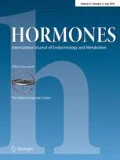Abstract
“Lady with an Ermine” (1489–1490) is an oil on walnut portrait by the Italian artist Leonardo da Vinci. The portrait’s subject is Cecilia Gallerani, the favorite mistress of Ludovico Sforza, known as “il Moro”, Duke of Milan. It was painted around the time of Cecilia’s pregnancy with Ludovico’s illegitimate son. Leonardo’s paintings are famous for hiding mysteries; thus, the truth about the “Lady with an Ermine” is still unclear. However, the solution to this enigma could be more evident than expected. Our hypothesis is that Cecilia might have suffered from pregnancy-induced Cushing syndrome.
Similar content being viewed by others
“Lady with an Ermine” (1489–1490) is an oil on walnut portrait by the Italian artist Leonardo da Vinci, which is currently kept in the Czartoryski Museum, Kracow, Poland. The portrait’s subject is Cecilia Gallerani, painted around the time of Cecilia’s pregnancy with the illegitimate son of Ludovico Sforza, Duke of Milan [1].
Leonardo’s paintings [2] are famous for hiding mysteries [3], and the attribution of endocrinological diseases to subjects painted by Leonardo is not new [4, 5]. The truth about the “Lady with an Ermine” is still unclear, but the solution to this enigma could be more evident than expected.
Our hypothesis is that Cecilia might have suffered from pregnancy-induced Cushing syndrome (CS), and, in fact, clinical signs and specific features of this syndrome are manifested, such as the buffalo hump on the back, thin arms, and moon-like facies (Fig. 1).
As eloquently explained by Chaudhry and Singh in a recent review [6], CS is caused by prolonged exposure to high circulating levels of cortisol. The most common cause of cushingoid features is iatrogenic corticosteroid use, while some herbal preparations can also increase circulating corticosteroid levels, leading to CS. The disorder can interchangeably be called hypercortisolism. ACTH-dependent cortisol excess due to a pituitary adenoma is called Cushing disease, and it is responsible for 80% of endogenous CS.
Pregnancy-induced CS is rare, with an incidence rate of 2–25 per million per year in the general population [7]. The etiology of CS during pregnancy has been attributed to the aberrant-luteinizing hormone (LH)/human chorionic gonadotropin (hCG) receptor (LHCGR) [8]. Pregnancy-induced CS has indeed been frequently reported due to an adrenal neoplasm [9]. Since adrenal gland tumors occasionally respond to LH or hCG, these hormones might be responsible for the excessive growth and function of the tumor during pregnancy. It seems that LHCGR has an important role in the pathogenesis of pregnancy-induced CS. However, other pathogenic mechanisms have been proposed. Estrogen binding to estrogen receptor α (ERα) might enhance the adrenocortical adenocarcinoma (ACC) cell proliferation [10].
Physical examination of the CS pregnant patient may reveal increased fat deposits in the upper half of the body, leading to buffalo torso, decreased lean body mass, characteristic moon facies, thin arms and legs, proximal muscle weakness of the shoulder and hip girdle muscles, and paper-thin skin [7].
Furthermore, it has also been noted that the size of the ermine is larger than normal in the painting (Fig. 1). This alteration of the animal’s anatomical proportions makes the woman’s pathological morphological traits even more evident. In other words, the lady’s muscle weakness is highlighted by the fact of her holding the ermine which has been painted with abnormally developed musculature. It is hypothesized that Leonardo could have included this striking feature in the painting to further capture the observer’s attention.
References
Shell J (1992) Sironi G Cecilia Gallerani: Leonardo’s Lady with an Ermine. Artibus Et Historiae 13(25):47–66
Kemp M (2019) Leonardo da Vinci: The 100 Milestones. Sterling, New York City, New York. isbn:978-1454930426
Soranzo A, Newberry M (2015) The uncatchable smile in Leonardo da Vinci’s La Bella Principessa portrait. Vis Res 113:78–86. https://doi.org/10.1016/j.visres.2015.05.014
Lazzeri D, Pozzilli P (2018) “Madonna of the carnation”: Leonardo da Vinci (1452-1519). J Endocrinol Investig 41(7):879–880. https://doi.org/10.1007/s40618-018-0842-z
Martino E, Vitti P (2014) Endocrinology and art. Leonardo da Vinci “design of lady with Graves' disease” (1452-1519). J Endocrinol Investig 37(8):781. https://doi.org/10.1007/s40618-014-0099-0
Chaudhry HS, Singh G (2020) Cushing syndrome. In: StatPearls. StatPearls Publishing Copyright © 2020, StatPearls Publishing LLC., Treasure Island (FL)
Ildefonso-Najarro SP, Plasencia-Dueñas EA, Benites-Moya CJ, Carrion-Rojas J, Concepción-Zavaleta MJ (2020) Pregnancy during the course of Cushing’s syndrome: a case report and literature review. Endocrinol Diabetes Metab Case Rep 2020:20–0022. Online ahead of print. https://doi.org/10.1530/edm-20-0022
Rask E, Schvarcz E, Hellman P, Hennings J, Karlsson F, Rao C (2009) Adrenocorticotropin-independent Cushing’s syndrome in pregnancy related to overexpression of adrenal luteinizing hormone/human chorionic gonadotropin receptors. J Endocrinol Investig 32(4):313–316
Wy LA, Carlson HE, Kane P, Li X, Lei ZM, Rao CV (2002) Pregnancy-associated Cushing’s syndrome secondary to a luteinizing hormone/human chorionic gonadotropin receptor-positive adrenal carcinoma. Gynecol Endocrinol 16(5):413–417. https://doi.org/10.1080/gye.16.5.413.417
Yin X, Liu J (2020) Estrogen receptor α plays an important role in Cushing’s syndrome during pregnancy. Med Hypotheses 143:109817. https://doi.org/10.1016/j.mehy.2020.109817
Author information
Authors and Affiliations
Corresponding author
Additional information
Publisher’s note
Springer Nature remains neutral with regard to jurisdictional claims in published maps and institutional affiliations.
Rights and permissions
About this article
Cite this article
Sisti, A., Sadeghi, P. Leonardo da Vinci: the Lady with an Ermine enigma. Hormones 20, 591–592 (2021). https://doi.org/10.1007/s42000-020-00264-0
Received:
Accepted:
Published:
Issue Date:
DOI: https://doi.org/10.1007/s42000-020-00264-0





